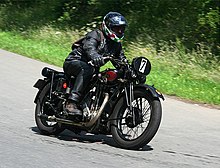Imperia vehicle plant
| Imperia Fahrzeugwerk GmbH | |
|---|---|
| legal form | Company with limited liability |
| founding | 1924 (as Cologne motorcycle and mechanical engineering company Dr. Franz Becker ) |
| resolution | 1935 |
| Seat |
|
| Branch | Motor vehicle manufacturer |
The Imperia car GmbH in Bad Godesberg was a manufacturer of Imperia motorbikes.
history
In 1924 the company was founded in Cologne-Kalk as the Cologne-based motorcycle and mechanical engineering company Dr. Franz Becker (KMB) founded. A year later it traded as Imperia-Werk Motorradbau GmbH , Cologne-Kalk, and there was also Imperia Vertriebs-Gesellschaft mbH , based in Cologne, Hohenzollernring 65. In 1926, Rolf Schrödter bought the company and relocated production to Bad Godesberg.
The best advertising for the “Imperia” brand was its success in racing, especially in the 350 class with the British single-cylinder “Python” engine from Rudge under the drivers Ernst Loof , Hein Thorn Prikker as well as Heinrich Berhausen, Josef Pütz, Adam Schumacher and Arthur Dom . Loof won the German motorcycle road championship in the 350 cm³ class three times on Imperia and the Eifel race on the Nürburgring several times , both as a solo driver and as a team driver.
As a result of the political developments in the 1930s, Rudge stopped supplying the racing engines to Imperia, so that Schrödter himself designed a 348 cc two-stroke racing engine and a 498 cc two-stroke sports engine. However, the implementation of these projects exceeded the company's financial resources, whereupon Imperia ceased operations in 1935.
Motorcycle types
- 1925: JI / engine: 350 cm³, 9 HP, 1 cylinder, 4-stroke
- 1925: 350 B / engine: Bradshaw OHV, 350 cm³, 10 HP, 1 cylinder, 4-stroke
- 1925: BS / engine: 350 cm³, 14 HP, 1 cylinder, 4-stroke
- 1925: J II / engine: 500 cm³, 15 HP, 1 cylinder, 4-stroke
- 1925: MI / engine: 500 cm³, 16 HP, 2 cylinders, 4-stroke
- 1926–1935: Engine: MAG 496 cm³ 22 HP 1 cylinder, 4-stroke ohv
- 1929–1930: Berggeist / engine: MAG, 595 cm³, 15 HP, 1 cylinder, 4-stroke
- 1929–1931: 500 H Sport / engine: MAG, 496 cm³, 22 HP, 1 cylinder, 4-stroke, 3-speed
- 1931–1933: Junior 200 / engine: Omnia or Villiers, 200 cm³, 6 HP, 1 cylinder, 2-stroke, 3-speed
- 1932: Grand Prix / engine: Rudge Python (four valves), 350 cm³, 18/20 HP, 1 cylinder, 4-stroke, 4-speed
- 1933–1935: Imperia 200 / Junior 200 / engine: Bark, 200 cm³, 8/10 HP, 1 cylinder, 4-stroke, 3-speed
- 1933: Zwerg 150 / engine: Villiers, 150 cm³, 3 HP, 1 cylinder, 2-stroke, 3-speed
- 1933: 350 H Sport / engine: MAG, 350 cm³, 15 HP, 1 cylinder, 4-stroke, 3-speed
- 1934: 350 B Sport / engine: Bark, 350 cm³, 15 HP, 1 cylinder, 4-stroke, 3-speed
Automobiles
In 1934 and 1935 automobiles were also produced, but only prototypes. They were small cars with a two-seater coupé body. A three - cylinder radial engine with 750 cm³ displacement and OHV valve control , which was mounted in the rear, provided the drive.
Web links
- Imperia motorcycle
- GTÜ Society for technical monitoring for motorcycle production
- GTÜ Society for Technical Monitoring for Automobile Production
Individual evidence
- ↑ Harald H. Linz, Halwart Schrader : The International Automobile Encyclopedia . United Soft Media Verlag, Munich 2008, ISBN 978-3-8032-9876-8 , Chapter Imperia (II).



